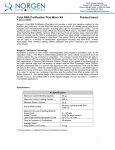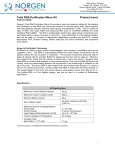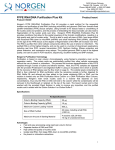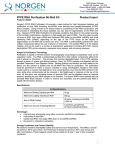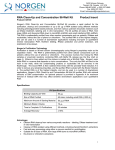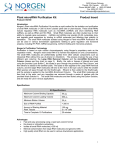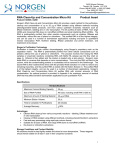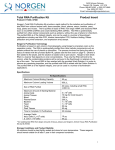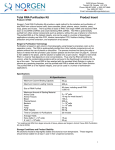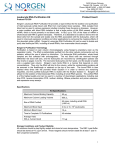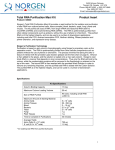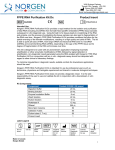Download Protocol - Geneflow Home - Molecular Biology Product Suppliers
Transcript
3430 Schmon Parkway Thorold, ON, Canada L2V 4Y6 Phone: 866-667-4362 (905) 227-8848 Fax: (905) 227-1061 Email: [email protected] Single Cell RNA Purification Kit Product Insert Product # 51800 Norgen’s Single Cell RNA Purification Kit provides a rapid and sensitive method for the isolation and purification of total RNA from small input amounts of cultured animal cells, sorted cells, and microdissected samples including laser-capture microdissection (LCM). The kit can recover RNA 5 from as little as a single cell to 2 x 10 cells. The kit purifies all sizes of RNA, from large mRNA and ribosomal RNA down to microRNA (miRNA) and small interfering RNA (siRNA). The RNA is preferentially purified from other cellular components such as proteins without the use of phenol or chloroform. The purified RNA is of the highest integrity, and can be used in a number of downstream applications including real time PCR, reverse transcription PCR, Northern blotting, RNase protection and primer extension, and expression array assays. Norgen’s Purification Technology Purification is based on spin column chromatography using Norgen’s proprietary resin as the separation matrix. The RNA is preferentially purified from other cellular components such as proteins without the use of phenol or chloroform. The process involves first lysing the cells with the provided Buffer RL (please see the flow chart on page 4). Ethanol is then added to the lysate, and the solution is loaded onto a Single Cell RNA Spin Column. Norgen’s resin binds RNA in a manner that depends on ionic concentrations. Thus only the RNA will bind to the column, while the contaminating proteins will be removed in the flowthrough or retained on the top of the resin. The bound RNA is then washed with the provided Wash Solution A in order to remove any remaining impurities, and the purified total RNA is eluted with the Elution Solution A. The special design of the micro spin-column allows a small elution volume of as little as 8 L. The purified RNA is of the highest integrity, and can be used in a number of downstream applications. Specifications Kit Specifications Maximum Column Binding Capacity 10 g Maximum Column Loading Volume 650 L Minimum Elution Volume 8 L Size of RNA Purified All sizes, including small RNA (<200 nt) Acceptable Amount of Starting Material: Animal Cells Laser-Captured Microdissection (LCM) Single Cell to 2 x 10 cells 5 Up to 2 x 10 cells Time to Complete 10 Purifications 20 minutes Average Yields 5 HeLa Cells (1 x 10 cells) HeLa Cells (100 cells) HeLa Cells (1 cell) ~ 1.5 g ~ 1.5 ng > 1 pg 5 1 Advantages Fast and easy processing using rapid spin-column format Small elution volume of 8 L Isolate total RNA, from large rRNA down to microRNA (miRNA) without compromising total yield No phenol or chloroform extractions Isolate high quality total RNA from a variety of sources RNA can be isolated and detected from as little as a single animal cell Kit Components Component Buffer RL Wash Solution A Elution Solution A Single Cell RNA Spin Columns Collection Tubes Elution tubes (1.7 mL) Product Insert Product # 51800 (50 preps) 40 mL 38 mL 6 mL 50 50 50 1 Storage Conditions and Product Stability All solutions should be kept tightly sealed and stored at room temperature. These reagents should remain stable for at least 1 year in their unopened containers. Precautions and Disclaimers This kit is designed for research purposes only. It is not intended for human or diagnostic use. Ensure that a suitable lab coat, disposable gloves and protective goggles are worn when working with chemicals. For more information, please consult the appropriate Material Safety Data Sheets (MSDSs). These are available as convenient PDF files online at www.norgenbiotek.com. The Buffer RL contains guanidine salts, and should be handled with care. Guanidine salt forms highly reactive compounds when combined with bleach, thus care must be taken to properly dispose of any of these solutions. 2 Customer-Supplied Reagents and Equipment You must have the following in order to use the Single Cell RNA Purification Kit: For All Protocols Benchtop microcentrifuge 96 - 100% ethanol -mercaptoethanol (optional) For Single Cell Protocol 96-well collection plate for cell collection For Animal Cell Protocol PBS (RNase-free) For Laser-Captured Microdissection (LCM) Protocol Sterile fine forceps o Water bath or heat block set at 42 C 70% ethanol Working with RNA RNases are very stable and robust enzymes that degrade RNA. Autoclaving solutions and glassware is not always sufficient to actively remove these enzymes. The first step when preparing to work with RNA is to create an RNase-free environment. The following precautions are recommended as your best defense against these enzymes. The RNA area should be located away from microbiological work stations Clean, disposable gloves should be worn at all times when handling reagents, samples, pipettes, disposable tubes, etc. It is recommended that gloves are changed frequently to avoid contamination There should be designated solutions, tips, tubes, lab coats, pipettes, etc. for RNA only All RNA solutions should be prepared using at least 0.05% DEPC-treated autoclaved water or molecular biology grade nuclease-free water Clean all surfaces with commercially available RNase decontamination solutions When working with purified RNA samples, ensure that they remain on ice during downstream applications 3 Flowchart Procedure for Purifying Total RNA using Norgen’s Single Cell RNA Purification Kit Lyse cells or tissue using Buffer RL Add Ethanol Bind to column SPIN Wash three times with Wash Solution A SPIN Elute RNA with Elution Solution A SPIN Purified Total RNA 4 Procedures All centrifugation steps are carried out in a benchtop microcentrifuge. Various speeds are required for different steps, so please check your microcentrifuge specifications to ensure that it is capable of the proper speeds. All centrifugation steps are performed at room temperature. The correct rpm can be calculated using the formula: RPM = RCF (1.118 x 10-5) (r) where RCF = required gravitational acceleration (relative centrifugal force in units of g); r = radius of the rotor in cm; and RPM = the number of revolutions per minute required to achieve the necessary g-force. Section 1. Preparation of Lysate From Various Cell Types Notes Prior to Use The steps for preparing the lysate are different depending on the starting material (Step 1). However, the subsequent steps are the same in all cases (Steps 2 – 6). Please ensure that the correct procedure for preparing the lysate from your starting material is followed. All centrifugation steps are carried out in a benchtop microcentrifuge at 14,000 x g (~ 14,000 RPM) except where noted. All centrifugation steps are performed at room temperature. A variable speed centrifuge should be used for maximum kit performance. If a variable speed centrifuge is not available a fixed speed centrifuge can be used, however reduced yields may be observed. Ensure that all solutions are at room temperature prior to use. Prepare a working concentration of the Wash Solution A by adding 90 mL of 96 - 100% ethanol (provided by the user) to the supplied bottle containing the concentrated Wash Solution A. This will give a final volume of 128 mL. The label on the bottle has a box that may be checked to indicate that the ethanol has been added. Optional: The use of -mercaptoethanol in lysis is highly recommended for most animal tissues (LCM samples), particularly those known to have a high RNAse content (ex: pancreas). It is also recommended for users who wish to isolate RNA for sensitive downstream applications. Add 10 L of -mercaptoethanol (provided by the user) to each 1 mL of Buffer RL required. -mercaptoethanol is toxic and should be dispensed in a fume hood. Alternatively, the Buffer RL can be used as provided. It is important to work quickly during this procedure. 1A. Lysate Preparation from Single Animal Cell Notes Prior to Use Freshly sorted cells are recommended for this protocol. Cells can be sorted by various procedures including classic flow cytometry and fluorescence-activated cell sorting (FACS) Ensure that all the components of the flow cytometer (such as dip tube, septa, flow cell, all tubing lines, and nozzles) are decontaminated for RNases using an appropriate reagent 1A. Cell Lysate Preparation from Single Cell or Sorted Cells a. Aliquot 100 L of Buffer RL to an RNase-free microcentrifuge tube or into each well of a 96-well collection plate. 5 b. Sort the cells directly into the aliquoted Buffer RL. Mix by pipetting up and down a few times. If the cells are collected onto a 96-well plate, transfer the lysate to an RNase-free microcentrifuge tube. c. Add 100 L of 70% ethanol (provided by the user) to the lysate. Mix by vortexing. 1B. Lysate Preparation from Cultured Animal Cells Notes Prior to Use 5 The maximum recommended input of cells is 2 x 10 . A hemocytometer can be used in conjunction with a microscope to count the number of cells. As a general guideline, each 4 well of a confluent 96-well plate of HeLa cells will contain 2-5 x 10 cells. Cell pellets can be stored at -70°C for later use or used directly in the procedure. Determine the number of cells present before freezing. Frozen pellets should be stored for no longer than 2 weeks to ensure that the integrity of the RNA is not compromised. Frozen cell pellets should not be thawed prior to beginning the protocol. Add the Buffer RL directly to the frozen cell pellet (Step 1B(ii) c). 1B(i). Cell Lysate Preparation from Cells Growing in a Monolayer a. Aspirate media and wash cell monolayer with an appropriate amount of PBS. Aspirate PBS. b. Add 200 L of Buffer RL directly to culture plate. c. Lyse cells by gently tapping culture dish and swirling buffer around plate surface for five minutes. d. Transfer lysate to a microcentrifuge tube. e. Add 120 L of 96 – 100% ethanol (provided by the user) to the lysate. Mix by vortexing for 10 seconds. Proceed to Step 2. 1B (ii). Cell Lysate Preparation from Cells Growing in Suspension and Lifted Cells a. Transfer cell suspension to an RNase-free tube (not provided) and centrifuge at no more than 200 x g (~2,000 RPM) for 10 minutes to pellet cells. b. Carefully decant the supernatant. Note: For inputs of over 10 cells, 5-10 L of media may be left behind with the pellet in order to ensure that the pellet is not dislodged. For inputs of fewer 5 than 10 cells, 30-50 L of media may be left behind in order to ensure that the pellet, which could be invisible, is not dislodged. 5 Add 350 L of Buffer RL to the pellet. Lyse cells by vortexing for 15 seconds. Ensure that the entire pellet is completely dissolved before proceeding to the next step. d. Add 200 L of 96 - 100% ethanol (provided by the user) to the lysate. Mix by vortexing for 10 seconds. Proceed to Step 2. c. 1C. Lysate Preparation from Laser-Captured Microdissection (LCM) Notes Prior to Use LCM samples obtained from frozen sections are recommended. Formalin-Fixed, ParaffinEmbedded sections may also be used. However, RNA isolated from FFPE samples generally has poorer quality than that from frozen sections. 6 1C. Cell Lysate Preparation from Laser-Captured Microdissection (LCM) a. Aliquot 300 L of Buffer RL to an RNase-free microcentrifuge tube. b. Remove the thermoplastic film containing the captured cells using sterile fine forceps. Carefully submerge the sample into the aliquoted Buffer RL. Close the microcentrifuge cap. o c. Incubate the sample at 42 C for 30 minutes. Apply vortex for 15 seconds after every 10 minutes. d. At the end of the incubation, vortex the tube one more time for 15 seconds. The thermoplastic film may be removed at this point using sterile fine forceps. Otherwise, proceed to Step 1Ce. e. Add 300 L of 70% ethanol (provided by the user) to the lysate. Vortex to mix. Proceed to Step 2. Section 2. Total RNA Purification from All Types of Lysate Note: The remaining steps of the procedure for the purification of total RNA are the same from this point forward for all the different types of lysate. 2. Binding RNA to Column a. Assemble a Single Cell RNA Spin Column with one of the provided collection tubes b. Apply up to 600 L of the lysate with the ethanol (from Step 1) onto the column and centrifuge for 1 minute at 3,500 x g (~6,000 RPM). Note: Ensure the entire lysate volume has passed through into the collection tube by inspecting the column. If the entire lysate volume has not passed, spin for an additional minute at 14,000 x g (~14,000 RPM). c. Discard the flowthrough. Reassemble the spin column with its collection tube. d. Depending on your lysate volume, repeat Step 2b and 2c as necessary. Optional Step: Norgen’s Single Cell RNA Purification Kit isolates total RNA with minimal amounts of genomic DNA contamination. However, an optional On-Column DNA Removal Protocol is provided in Appendix A for maximum removal of residual DNA that may affect sensitive downstream applications. It is recommended that Norgen’s RNase-Free DNase I Kit (Product # 25710) be used for this step. This step should be performed at this point in the protocol. 3. Column Wash a. Apply 400 L of Wash Solution A to the column and centrifuge for 1 minute at 14,000 x g (~14,000 RPM). Note: Ensure the entire Wash Solution A has passed through into the collection tube by inspecting the column. If the entire wash volume has not passed, spin for an additional minute. b. Discard the flowthrough and reassemble the spin column with its collection tube. c. Repeat steps 3a and 3b to wash column a second time. d. Wash column a third time by adding another 400 L of Wash Solution A and centrifuging for 1 minute at 14,000 x g (~14,000 RPM). e. Discard the flowthrough and reassemble the spin column with its collection tube. 7 f. Spin the column for 2 minutes at 14,000 x g (~14,000 RPM) in order to thoroughly dry the resin. Discard the collection tube. 4. RNA Elution a. Place the column into a fresh 1.7 mL Elution tube provided with the kit. b. Add 8 - 20 L of Elution Solution A to the column. Note: For higher concentrations of RNA, a lower elution volume may be used. A minimum volume of 8 L is recommended c. Centrifuge for 1 minutes at 200 x g (~2,000 RPM), followed by 1 minute at 14,000 x g (~14,000 RPM) Note the volume eluted from the column. If the entire volume has not been eluted, spin the column at 14,000 x g (~14,000 RPM) for 1 additional minute. 5. Storage of RNA The purified RNA sample may be stored at –20°C for a few days. It is recommended that samples be placed at –70°C for long term storage. 6. Quantification of RNA 5 For cell inputs of ≥ 1 x 10 cells, it is possible to quantify RNA using a 2 nanospectrophotometer (such as Thermo Scientific's NanoDrop). For cell inputs between 10 5 and 10 cells, RNA quantification requires a highly sensitive fluorescence-based system (such as Life Technologies' RiboGreen® RNA Assay kit). For cell inputs between a single cell 4 and 10 cells, quantification could be performed using RT-qPCR of an RNA transcript of high abundance (such as GAPDH or 5S rRNA) with a standard curve generated with total RNA of known concentration. Appendix A Protocol for Optional On-Column DNA Removal Norgen’s Single Cell RNA Purification Kit isolates total RNA with minimal amounts of genomic DNA contamination. However, an optional protocol is provided below for maximum removal of residual DNA that may affect sensitive downstream applications. It is recommended that Norgen’s RNase-Free DNase I Kit (Product # 25710) be used for this step. 1. For every on-column reaction to be performed, prepare a mix of 15 L of DNase I and 100 µL of Enzyme Incubation Buffer using Norgen’s RNase-Free DNase I Kit (Product # 25710). Mix gently by inverting the tube a few times. DO NOT VORTEX. Note: If using an alternative DNase I, prepare a working stock of 0.25 Kunitz unit/L RNase-free DNase I solution according to the manufacturer’s instructions. A 100 L aliquot is required for each column to be treated. 2. Perform the appropriate Total RNA Isolation Procedure for your starting material up to and including “Binding to Column” (Steps 1 and 2 of all protocols) 3. Apply 400 L of Wash Solution A to the micro spin column and centrifuge for 2 minute. Discard the flowthrough. Reassemble the spin column with its collection tube. 4. Apply 100 L of the RNase-free DNase I solution prepared in Step 1 to the column and centrifuge at 14, 000 x g (~14 000 RPM) for 1 minute. Note: Ensure that the entire DNase I solution passes through the column. If needed, spin at 14, 000 x g (~14 000 RPM) for an additional minute. 5. After the centrifugation in Step 4, pipette the flowthrough that is present in the collection tube back onto the top of the column. 8 Note: Ensure Step 5 is performed in order to ensure maximum DNase activity and to obtain maximum yields of RNA, in particular for small RNA species. o 6. Incubate the column assembly at 25 - 30 C for 15 minutes. 7. Without any further centrifugation, proceed directly to the second wash step in the “Column Wash” section (Step 3c). Troubleshooting Guide Problem Poor RNA Recovery Clogged Column Possible Cause Solution and Explanation Incomplete lysis of cells or tissue Ensure that the appropriate amount of Buffer RL was used for the amount of cells or tissue. Column has become clogged Do not exceed the recommended amounts of starting materials. The amount of starting material may need to be decreased if the column shows clogging below the recommended levels. See also “Clogged Column” below. An alternative elution solution was used It is recommended that the Elution Solution A supplied with this kit be used for maximum RNA recovery. Ethanol was not added to the lysate Ensure that the appropriate amount of ethanol is added to the lysate before binding to the column. Ethanol was not added to the Wash Solution A Ensure that 90 mL of 96-100% ethanol is added to the supplied Wash Solution A prior to use. Low RNA content in cells or tissues used Different tissues and cells have different RNA contents, and thus the expected yield of RNA will vary greatly from these different sources. Please check literature to determine the expected RNA content of your starting material. Cell Culture: Cell monolayer was not washed with PBS Ensure that the cell monolayer is washed with the appropriate amount of PBS in order to remove residual media from cells. LCM: Sample was not incubated at o 42 C for 30 minutes Ensure that the incubation at 42 C for the removal and lysis of cells from the thermoplastic film. Centrifuge temperature too low Ensure that the centrifuge remains at room temperature throughout the procedure. Temperatures below 15°C may cause precipitates to form that can cause the columns to clog. o 9 Problem RNA does not perform well in downstream applications RNA is Degraded Genomic DNA contamination Possible Cause Solution and Explanation RNA was not washed 3 times with the provided Wash Solution A Traces of salt from the binding step may remain in the sample if the column is not washed 3 times with Wash Solution A. Salt may interfere with downstream applications, and thus must be washed from the column. Ethanol carryover Ensure that the dry spin under the Column Wash procedure is performed, in order to remove traces of ethanol prior to elution. Ethanol is known to interfere with many downstream applications. RNase contamination RNases may be introduced during the use of the kit. Ensure proper procedures are followed when working with RNA. Please refer to “Working with RNA” at the beginning of this user guide. Procedure not performed quickly enough In order to maintain the integrity of the RNA, it is important that the procedure be performed quickly. This is especially important for the Cell Lysate Preparation Step in the Animal Tissue protocol, since the RNA in animal tissues is not protected after harvesting until it is disrupted and homogenized. Improper storage of the purified RNA For short term storage RNA samples may be stored at –20°C for a few days. It is recommended that samples be stored at –70°C for longer term storage. Frozen tissues or cell pellets were allowed to thaw prior to RNA isolation Do not allow frozen tissues to thaw prior to grinding with the mortar and pestle in order to ensure that the integrity of the RNA is not compromised. Starting material may have a high RNase content For starting materials with high RNAase content, it is recommended that -mercaptoethanol be added to the Buffer RL. Large amounts of starting material used Perform RNAse-free DNaseI digestion on the RNA sample after elution to remove genomic DNA contamination. It is recommended that Norgen’s RNaseFree DNase I Kit (Product # 25710) be used for this step. 10 Related Products Proteinase K – 2 Vials RNase-Free DNase I Kit Total RNA Purification Kit Total RNA Purification 96-Well Kit Total RNA Purification Maxi Kit Animal Tissue RNA Purification Kit Plant/Fungi Total RNA Purification Kit RNA/Protein Purification Kit RNA/DNA/Protein Purification Kit Cytoplasmic & Nuclear RNA Purification Kit Leukocyte RNA Purification Kit microRNA Purification Kit 100b RNA Ladder 1kb RNA Ladder Product # 17904 25710 17200 24300 26800 25700 25800 24100 24000 21000 21200 21300 15002 15003 Technical Support Contact our Technical Support Team between the hours of 8:30 and 5:30 (Eastern Standard Time) at (905) 227-8848 or Toll Free at 1-866-667-4362. Technical support can also be obtained from our website (www.norgenbiotek.com) or through email at [email protected]. 3430 Schmon Parkway, Thorold, ON Canada L2V 4Y6 Phone: (905) 227-8848 Fax: (905) 227-1061 Toll Free in North America: 1-866-667-4362 ©2014 Norgen Biotek Corp. PI51800-3-M14 11











